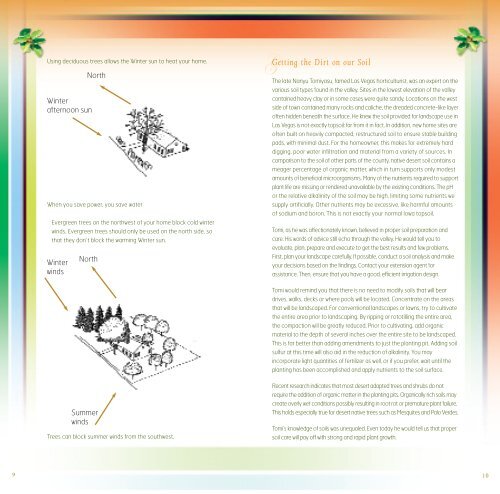trees for Tomorrow.pdf - Nevada Division of Forestry
trees for Tomorrow.pdf - Nevada Division of Forestry
trees for Tomorrow.pdf - Nevada Division of Forestry
You also want an ePaper? Increase the reach of your titles
YUMPU automatically turns print PDFs into web optimized ePapers that Google loves.
Using deciduous <strong>trees</strong> allows the Winter sun to heat your home.<br />
Winter<br />
afternoon sun<br />
North<br />
When you save power, you save water<br />
Evergreen <strong>trees</strong> on the northwest <strong>of</strong> your home block cold winter<br />
winds. Evergreen <strong>trees</strong> should only be used on the north side, so<br />
that they don’t block the warming Winter sun.<br />
Winter<br />
winds<br />
North<br />
Summer<br />
winds<br />
Trees can block summer winds from the southwest.<br />
Getting the Dirt on our Soil<br />
The late Nanyu Tomiyasu, famed Las Vegas horticulturist, was an expert on the<br />
various soil types found in the valley. Sites in the lowest elevation <strong>of</strong> the valley<br />
contained heavy clay or in some cases were quite sandy. Locations on the west<br />
side <strong>of</strong> town contained many rocks and caliche, the dreaded concrete-like layer<br />
<strong>of</strong>ten hidden beneath the surface. He knew the soil provided <strong>for</strong> landscape use in<br />
Las Vegas is not exactly topsoil; far from it in fact. In addition, new home sites are<br />
<strong>of</strong>ten built on heavily compacted, restructured soil to ensure stable building<br />
pads, with minimal dust. For the homeowner, this makes <strong>for</strong> extremely hard<br />
digging, poor water infiltration and material from a variety <strong>of</strong> sources. In<br />
comparison to the soil <strong>of</strong> other parts <strong>of</strong> the county, native desert soil contains a<br />
meager percentage <strong>of</strong> organic matter, which in turn supports only modest<br />
amounts <strong>of</strong> beneficial microorganisms. Many <strong>of</strong> the nutrients required to support<br />
plant life are missing or rendered unavailable by the existing conditions. The pH<br />
or the relative alkalinity <strong>of</strong> the soil may be high, limiting some nutrients we<br />
supply artificially. Other nutrients may be excessive, like harmful amounts<br />
<strong>of</strong> sodium and boron. This is not exactly your normal Iowa topsoil.<br />
Tomi, as he was affectionately known, believed in proper soil preparation and<br />
care. His words <strong>of</strong> advice still echo through the valley. He would tell you to<br />
evaluate, plan, prepare and execute to get the best results and few problems.<br />
First, plan your landscape carefully. If possible, conduct a soil analysis and make<br />
your decisions based on the findings. Contact your extension agent <strong>for</strong><br />
assistance. Then, ensure that you have a good, efficient irrigation design.<br />
Tomi would remind you that there is no need to modify soils that will bear<br />
drives, walks, decks or where pools will be located. Concentrate on the areas<br />
that will be landscaped. For conventional landscapes or lawns, try to cultivate<br />
the entire area prior to landscaping. By ripping or rototilling the entire area,<br />
the compaction will be greatly reduced. Prior to cultivating, add organic<br />
material to the depth <strong>of</strong> several inches over the entire site to be landscaped.<br />
This is far better than adding amendments to just the planting pit. Adding soil<br />
sulfur at this time will also aid in the reduction <strong>of</strong> alkalinity. You may<br />
incorporate light quantities <strong>of</strong> fertilizer as well, or if you prefer, wait until the<br />
planting has been accomplished and apply nutrients to the soil surface.<br />
Recent research indicates that most desert adapted <strong>trees</strong> and shrubs do not<br />
require the addition <strong>of</strong> organic matter in the planting pits. Organically rich soils may<br />
create overly wet conditions possibly resulting in root rot or premature plant failure.<br />
This holds especially true <strong>for</strong> desert native <strong>trees</strong> such as Mesquites and Palo Verdes.<br />
Tomi’s knowledge <strong>of</strong> soils was unequaled. Even today he would tell us that proper<br />
soil care will pay <strong>of</strong>f with strong and rapid plant growth.<br />
9 10



